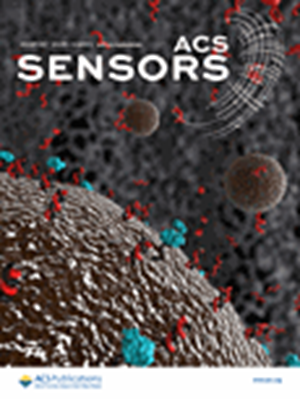Dual-Gate Modulation in a Quantum Dots/MoS2 Thin-Film Transistor Gas Sensor
IF 9.1
1区 化学
Q1 CHEMISTRY, ANALYTICAL
引用次数: 0
Abstract
Mastering the surface chemistry of quantum dots (QDs) has enabled a remarkable gas-sensing response as well as impressive air stability. To overcome the intrinsic receptor-transducer mismatch of QDs, PbS QDs used as sensitive NO2 receptors are spin-coated on top of a few-layer MoS2 and incorporated into a thin-film transistor (TFT) gas sensor. This architecture enables the separation of the electron transduction function from the chemical reception function. A comparison study through size engineering of QDs combined with TFT device modeling suggests a unique dual-gate modulation related to the capacitance coupling effect of QDs. The favorable increase in sensor output current by 3 orders of magnitude is ascribed to the high mobility of the few-layer MoS2. The optimal sensor exhibits a sensitive (LOD ∼ 0.6 ppb), selective, and recoverable response at room temperature. Because of the dual-gate modulation, the sensor performance is further optimized by varying the gate voltage (a two-fold increase in response to 1 ppm of NO2).

量子点/MoS2薄膜晶体管气体传感器的双栅调制
掌握量子点(QDs)的表面化学性质使其具有显著的气敏响应和令人印象深刻的空气稳定性。为了克服量子点的本征感受器-换能器失配,将用作敏感NO2受体的PbS量子点自旋涂覆在几层MoS2之上,并将其集成到薄膜晶体管(TFT)气体传感器中。这种结构使电子转导功能与化学接收功能分离。通过量子点尺寸工程与TFT器件建模的比较研究表明,量子点的电容耦合效应与独特的双栅调制有关。传感器输出电流增加了3个数量级,这归功于少层二硫化钼的高迁移率。最佳传感器在室温下表现出敏感(LOD ~ 0.6 ppb)、选择性和可恢复的响应。由于采用了双栅极调制,通过改变栅极电压(对1 ppm NO2的响应增加两倍),传感器性能得到了进一步优化。
本文章由计算机程序翻译,如有差异,请以英文原文为准。
求助全文
约1分钟内获得全文
求助全文
来源期刊

ACS Sensors
Chemical Engineering-Bioengineering
CiteScore
14.50
自引率
3.40%
发文量
372
期刊介绍:
ACS Sensors is a peer-reviewed research journal that focuses on the dissemination of new and original knowledge in the field of sensor science, particularly those that selectively sense chemical or biological species or processes. The journal covers a broad range of topics, including but not limited to biosensors, chemical sensors, gas sensors, intracellular sensors, single molecule sensors, cell chips, and microfluidic devices. It aims to publish articles that address conceptual advances in sensing technology applicable to various types of analytes or application papers that report on the use of existing sensing concepts in new ways or for new analytes.
 求助内容:
求助内容: 应助结果提醒方式:
应助结果提醒方式:


